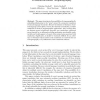IH
2005
Springer
13 years 10 months ago
2005
Springer
We describe a dynamic software watermark embedded in the memory trace of an executing Java program. Our approach is a generalisation of the spread–transform watermarking techniqu...
IH
2005
Springer
13 years 10 months ago
2005
Springer
This paper puts in consideration the concepts of security and robustness in watermarking, in order to be able to establish a clear frontier between them. A new information-theoreti...
IH
2005
Springer
13 years 10 months ago
2005
Springer
IH
2005
Springer
13 years 10 months ago
2005
Springer
There are many detectors for simple Least Significant Bit (LSB) steganography in digital images, the most sensitive of which make use of structural or combinatorial properties of ...
IH
2005
Springer
13 years 10 months ago
2005
Springer
Software protection is an area of active research in which a variety of techniques have been developed to address the issue. Examples of such techniques are software watermarking, ...
IH
2005
Springer
13 years 10 months ago
2005
Springer
This paper investigates the possibilities of steganographically embedding information in the \noise" created by automatic translation of natural language documents. Because th...
IH
2005
Springer
13 years 10 months ago
2005
Springer
Abstract. Wet paper codes were proposed as a tool for constructing steganographic schemes with an arbitrary selection channel that is not shared between the sender and the recipien...
IH
2005
Springer
13 years 10 months ago
2005
Springer
It is commonly believed that steganography within TCP/IP is easily achieved by embedding data in header fields seemingly filled with “random” data, such as the IP identifier...

